MLC703 - Negative Gearing: Analysis of Income Tax Law in Australia
VerifiedAdded on 2023/06/07
|11
|2135
|418
Essay
AI Summary
This essay provides an in-depth analysis of negative gearing within the Australian income tax system, referencing the Income Tax Assessment Act (ITAA) 1936 and ITAA 1997. It explores arguments for and against the tax deductibility of negatively geared investments and rental properties, considering factors such as motivation for taxpayers, investment encouragement, court protections, and the impact on tax revenue. The essay discusses the tacit approval of negative gearing by the Commissioner of Taxation and the popularity of this tax shelter, while also addressing concerns about its growing burden on tax revenue and potential inequities. The analysis concludes that while negative gearing contributes to revenue burdens, it is not inherently unfair or inefficient enough to warrant complete removal, suggesting a balanced approach to government revenue protection and taxpayer incentives.
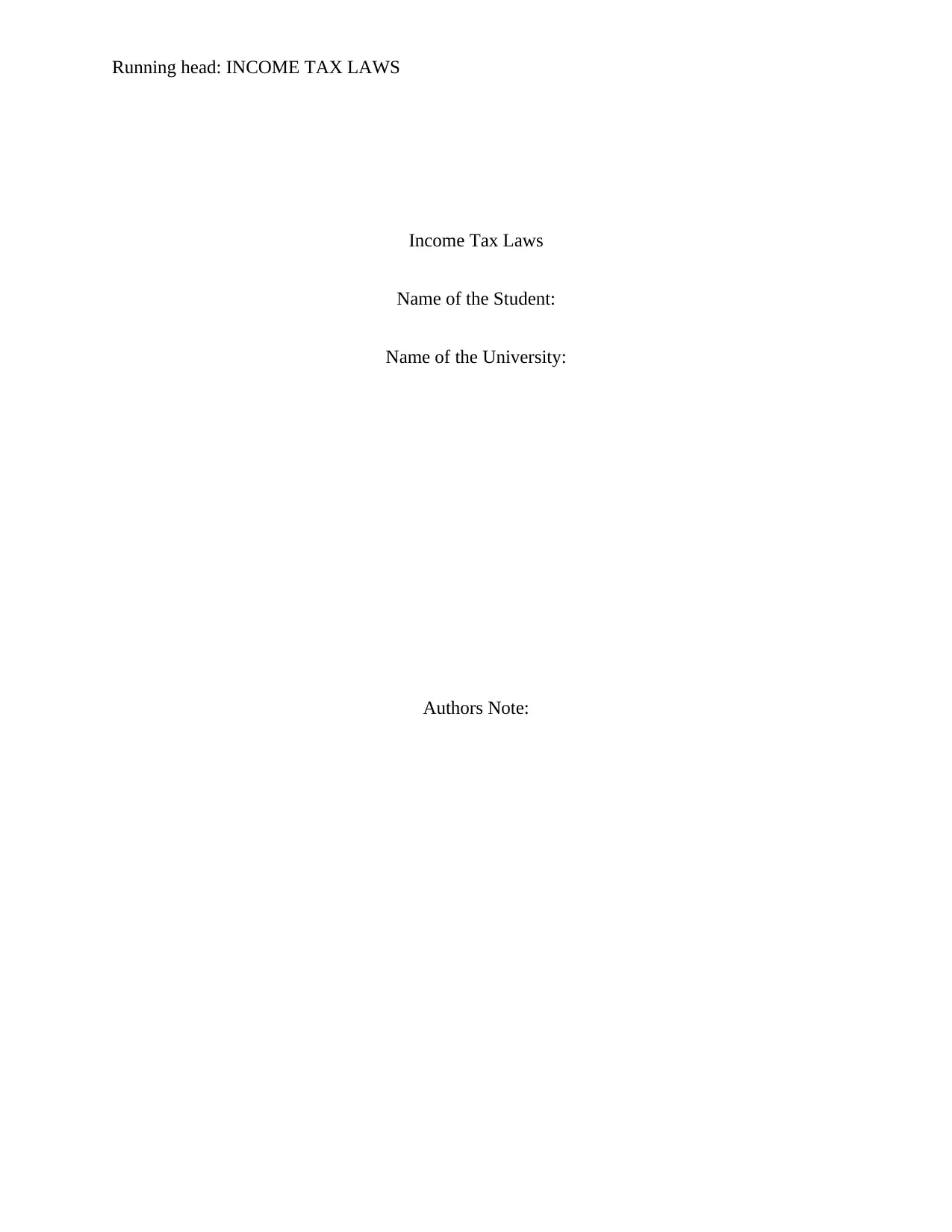
Running head: INCOME TAX LAWS
Income Tax Laws
Name of the Student:
Name of the University:
Authors Note:
Income Tax Laws
Name of the Student:
Name of the University:
Authors Note:
Paraphrase This Document
Need a fresh take? Get an instant paraphrase of this document with our AI Paraphraser
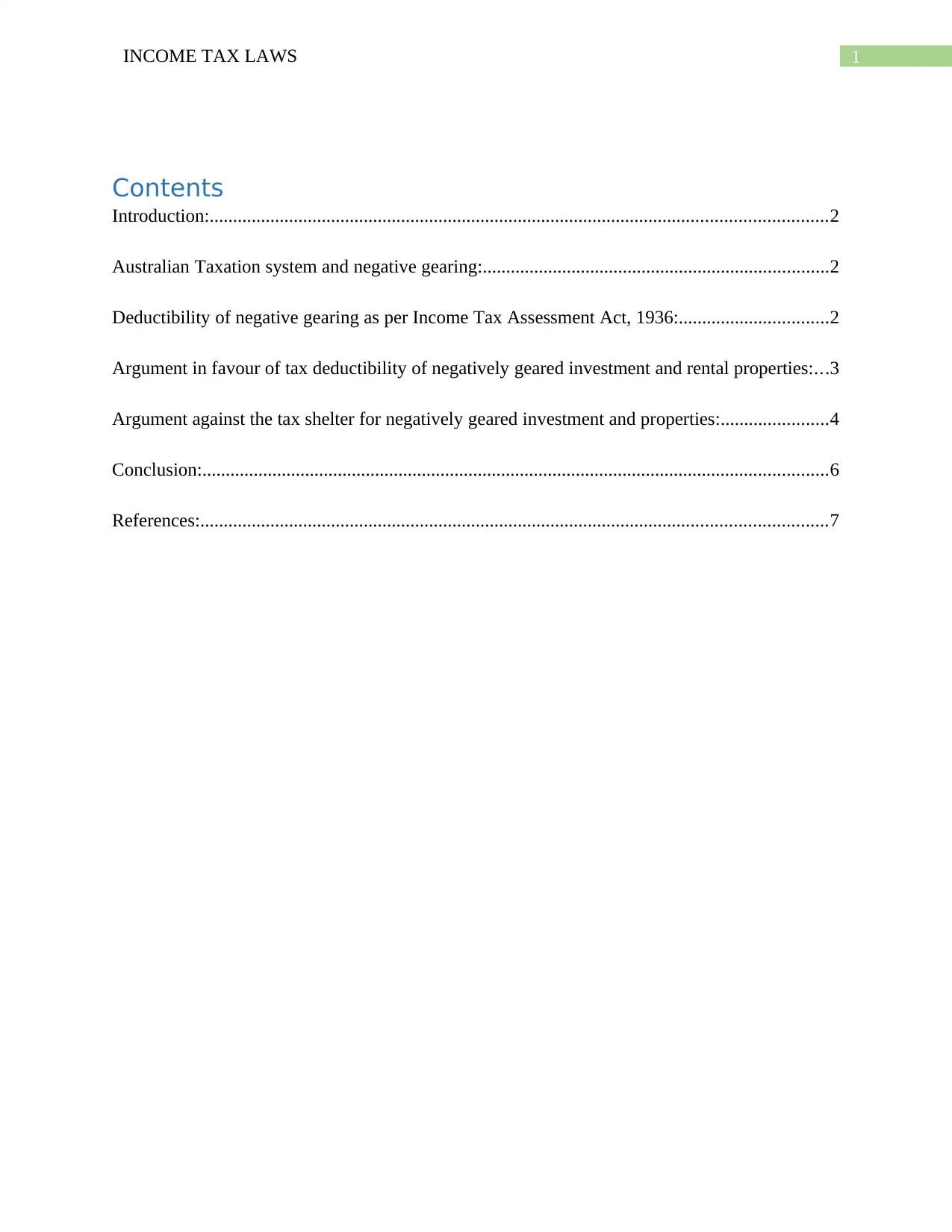
1INCOME TAX LAWS
Contents
Introduction:....................................................................................................................................2
Australian Taxation system and negative gearing:..........................................................................2
Deductibility of negative gearing as per Income Tax Assessment Act, 1936:................................2
Argument in favour of tax deductibility of negatively geared investment and rental properties:...3
Argument against the tax shelter for negatively geared investment and properties:.......................4
Conclusion:......................................................................................................................................6
References:......................................................................................................................................7
Contents
Introduction:....................................................................................................................................2
Australian Taxation system and negative gearing:..........................................................................2
Deductibility of negative gearing as per Income Tax Assessment Act, 1936:................................2
Argument in favour of tax deductibility of negatively geared investment and rental properties:...3
Argument against the tax shelter for negatively geared investment and properties:.......................4
Conclusion:......................................................................................................................................6
References:......................................................................................................................................7
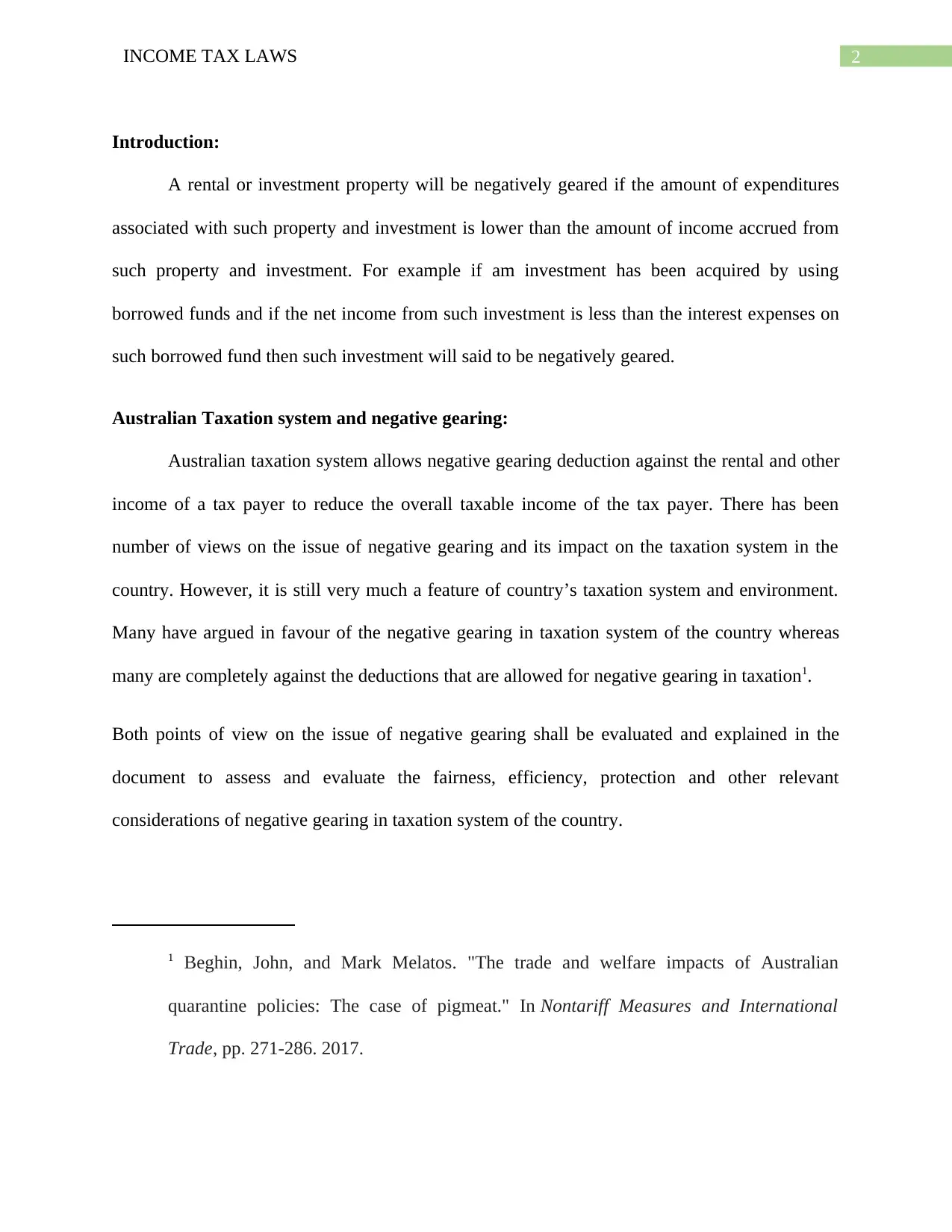
2INCOME TAX LAWS
Introduction:
A rental or investment property will be negatively geared if the amount of expenditures
associated with such property and investment is lower than the amount of income accrued from
such property and investment. For example if am investment has been acquired by using
borrowed funds and if the net income from such investment is less than the interest expenses on
such borrowed fund then such investment will said to be negatively geared.
Australian Taxation system and negative gearing:
Australian taxation system allows negative gearing deduction against the rental and other
income of a tax payer to reduce the overall taxable income of the tax payer. There has been
number of views on the issue of negative gearing and its impact on the taxation system in the
country. However, it is still very much a feature of country’s taxation system and environment.
Many have argued in favour of the negative gearing in taxation system of the country whereas
many are completely against the deductions that are allowed for negative gearing in taxation1.
Both points of view on the issue of negative gearing shall be evaluated and explained in the
document to assess and evaluate the fairness, efficiency, protection and other relevant
considerations of negative gearing in taxation system of the country.
1 Beghin, John, and Mark Melatos. "The trade and welfare impacts of Australian
quarantine policies: The case of pigmeat." In Nontariff Measures and International
Trade, pp. 271-286. 2017.
Introduction:
A rental or investment property will be negatively geared if the amount of expenditures
associated with such property and investment is lower than the amount of income accrued from
such property and investment. For example if am investment has been acquired by using
borrowed funds and if the net income from such investment is less than the interest expenses on
such borrowed fund then such investment will said to be negatively geared.
Australian Taxation system and negative gearing:
Australian taxation system allows negative gearing deduction against the rental and other
income of a tax payer to reduce the overall taxable income of the tax payer. There has been
number of views on the issue of negative gearing and its impact on the taxation system in the
country. However, it is still very much a feature of country’s taxation system and environment.
Many have argued in favour of the negative gearing in taxation system of the country whereas
many are completely against the deductions that are allowed for negative gearing in taxation1.
Both points of view on the issue of negative gearing shall be evaluated and explained in the
document to assess and evaluate the fairness, efficiency, protection and other relevant
considerations of negative gearing in taxation system of the country.
1 Beghin, John, and Mark Melatos. "The trade and welfare impacts of Australian
quarantine policies: The case of pigmeat." In Nontariff Measures and International
Trade, pp. 271-286. 2017.
⊘ This is a preview!⊘
Do you want full access?
Subscribe today to unlock all pages.

Trusted by 1+ million students worldwide
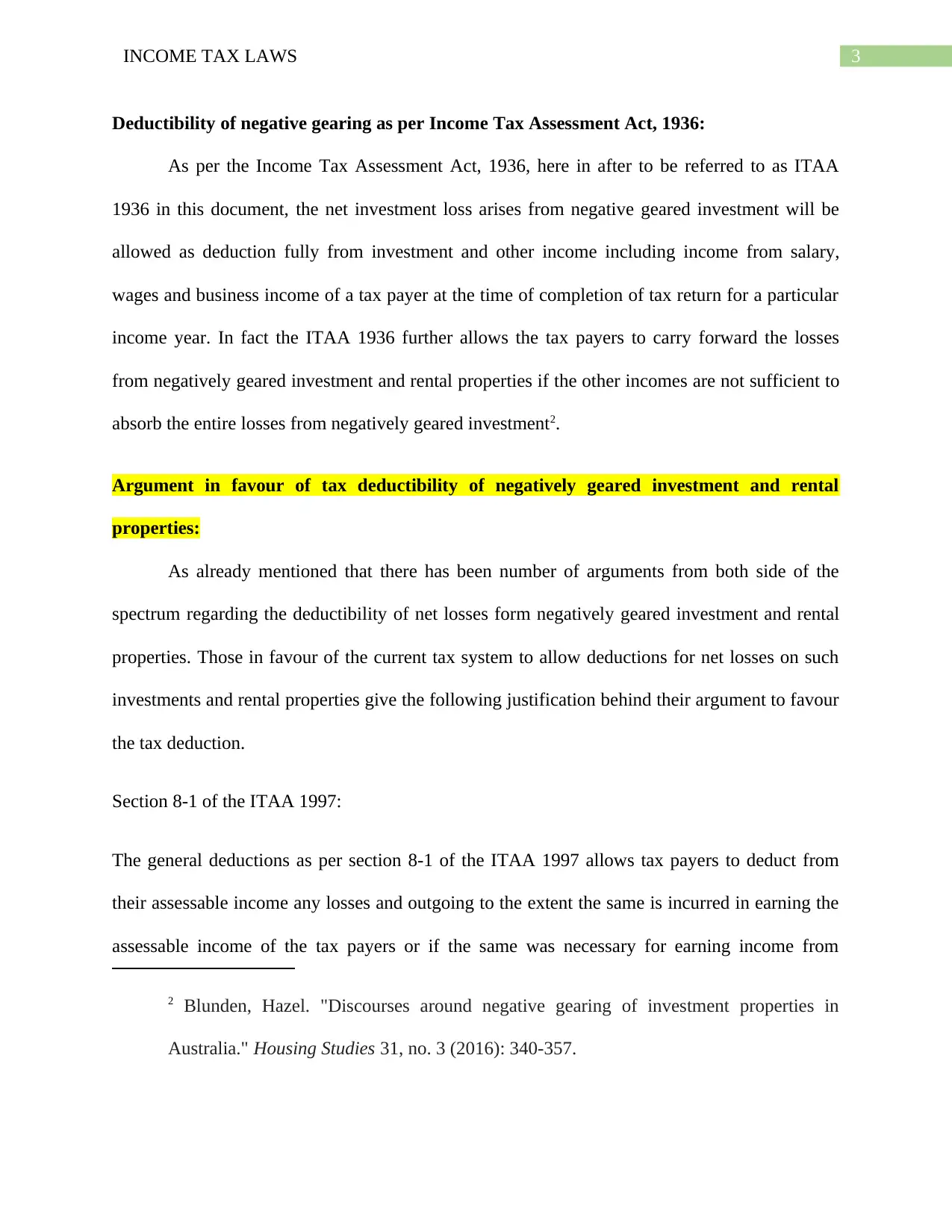
3INCOME TAX LAWS
Deductibility of negative gearing as per Income Tax Assessment Act, 1936:
As per the Income Tax Assessment Act, 1936, here in after to be referred to as ITAA
1936 in this document, the net investment loss arises from negative geared investment will be
allowed as deduction fully from investment and other income including income from salary,
wages and business income of a tax payer at the time of completion of tax return for a particular
income year. In fact the ITAA 1936 further allows the tax payers to carry forward the losses
from negatively geared investment and rental properties if the other incomes are not sufficient to
absorb the entire losses from negatively geared investment2.
Argument in favour of tax deductibility of negatively geared investment and rental
properties:
As already mentioned that there has been number of arguments from both side of the
spectrum regarding the deductibility of net losses form negatively geared investment and rental
properties. Those in favour of the current tax system to allow deductions for net losses on such
investments and rental properties give the following justification behind their argument to favour
the tax deduction.
Section 8-1 of the ITAA 1997:
The general deductions as per section 8-1 of the ITAA 1997 allows tax payers to deduct from
their assessable income any losses and outgoing to the extent the same is incurred in earning the
assessable income of the tax payers or if the same was necessary for earning income from
2 Blunden, Hazel. "Discourses around negative gearing of investment properties in
Australia." Housing Studies 31, no. 3 (2016): 340-357.
Deductibility of negative gearing as per Income Tax Assessment Act, 1936:
As per the Income Tax Assessment Act, 1936, here in after to be referred to as ITAA
1936 in this document, the net investment loss arises from negative geared investment will be
allowed as deduction fully from investment and other income including income from salary,
wages and business income of a tax payer at the time of completion of tax return for a particular
income year. In fact the ITAA 1936 further allows the tax payers to carry forward the losses
from negatively geared investment and rental properties if the other incomes are not sufficient to
absorb the entire losses from negatively geared investment2.
Argument in favour of tax deductibility of negatively geared investment and rental
properties:
As already mentioned that there has been number of arguments from both side of the
spectrum regarding the deductibility of net losses form negatively geared investment and rental
properties. Those in favour of the current tax system to allow deductions for net losses on such
investments and rental properties give the following justification behind their argument to favour
the tax deduction.
Section 8-1 of the ITAA 1997:
The general deductions as per section 8-1 of the ITAA 1997 allows tax payers to deduct from
their assessable income any losses and outgoing to the extent the same is incurred in earning the
assessable income of the tax payers or if the same was necessary for earning income from
2 Blunden, Hazel. "Discourses around negative gearing of investment properties in
Australia." Housing Studies 31, no. 3 (2016): 340-357.
Paraphrase This Document
Need a fresh take? Get an instant paraphrase of this document with our AI Paraphraser
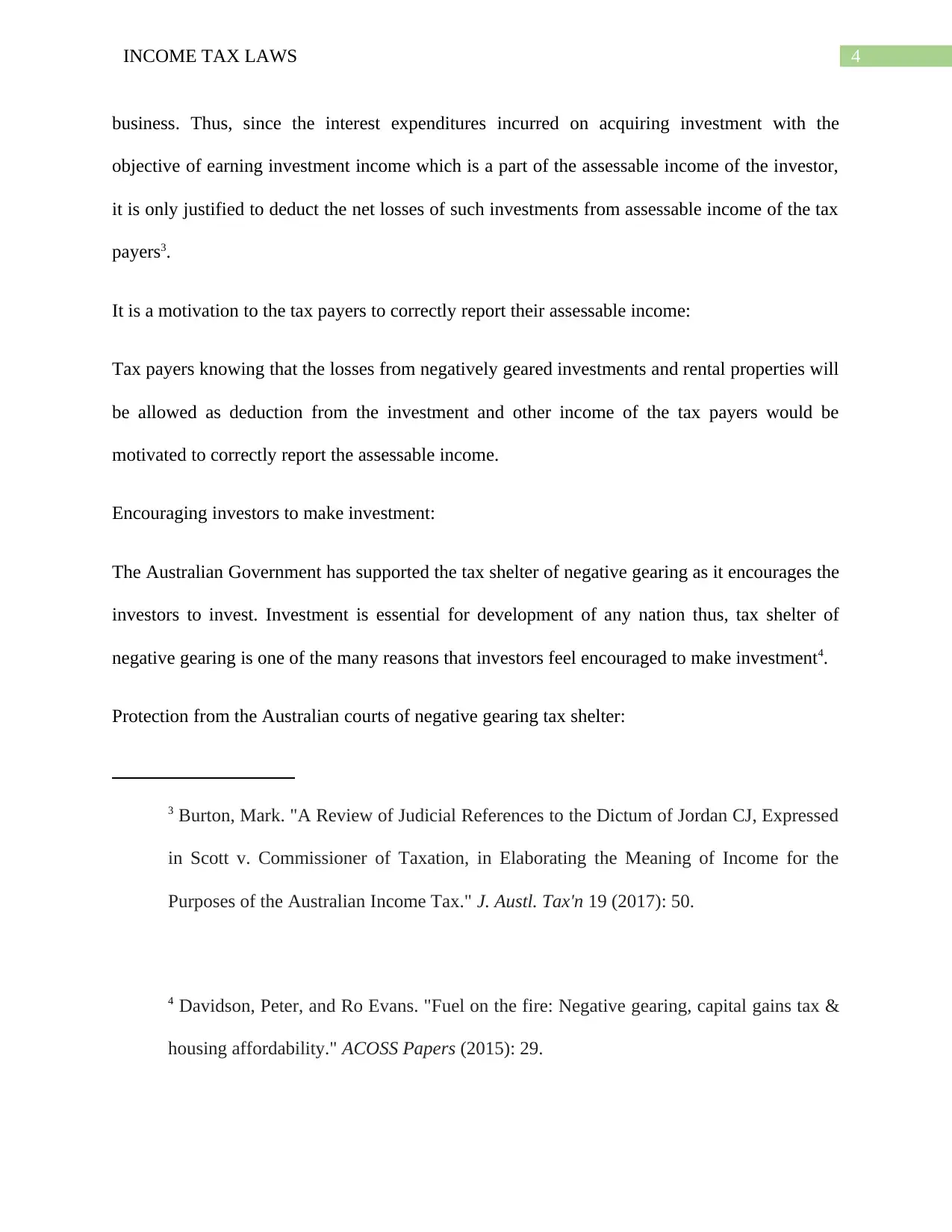
4INCOME TAX LAWS
business. Thus, since the interest expenditures incurred on acquiring investment with the
objective of earning investment income which is a part of the assessable income of the investor,
it is only justified to deduct the net losses of such investments from assessable income of the tax
payers3.
It is a motivation to the tax payers to correctly report their assessable income:
Tax payers knowing that the losses from negatively geared investments and rental properties will
be allowed as deduction from the investment and other income of the tax payers would be
motivated to correctly report the assessable income.
Encouraging investors to make investment:
The Australian Government has supported the tax shelter of negative gearing as it encourages the
investors to invest. Investment is essential for development of any nation thus, tax shelter of
negative gearing is one of the many reasons that investors feel encouraged to make investment4.
Protection from the Australian courts of negative gearing tax shelter:
3 Burton, Mark. "A Review of Judicial References to the Dictum of Jordan CJ, Expressed
in Scott v. Commissioner of Taxation, in Elaborating the Meaning of Income for the
Purposes of the Australian Income Tax." J. Austl. Tax'n 19 (2017): 50.
4 Davidson, Peter, and Ro Evans. "Fuel on the fire: Negative gearing, capital gains tax &
housing affordability." ACOSS Papers (2015): 29.
business. Thus, since the interest expenditures incurred on acquiring investment with the
objective of earning investment income which is a part of the assessable income of the investor,
it is only justified to deduct the net losses of such investments from assessable income of the tax
payers3.
It is a motivation to the tax payers to correctly report their assessable income:
Tax payers knowing that the losses from negatively geared investments and rental properties will
be allowed as deduction from the investment and other income of the tax payers would be
motivated to correctly report the assessable income.
Encouraging investors to make investment:
The Australian Government has supported the tax shelter of negative gearing as it encourages the
investors to invest. Investment is essential for development of any nation thus, tax shelter of
negative gearing is one of the many reasons that investors feel encouraged to make investment4.
Protection from the Australian courts of negative gearing tax shelter:
3 Burton, Mark. "A Review of Judicial References to the Dictum of Jordan CJ, Expressed
in Scott v. Commissioner of Taxation, in Elaborating the Meaning of Income for the
Purposes of the Australian Income Tax." J. Austl. Tax'n 19 (2017): 50.
4 Davidson, Peter, and Ro Evans. "Fuel on the fire: Negative gearing, capital gains tax &
housing affordability." ACOSS Papers (2015): 29.
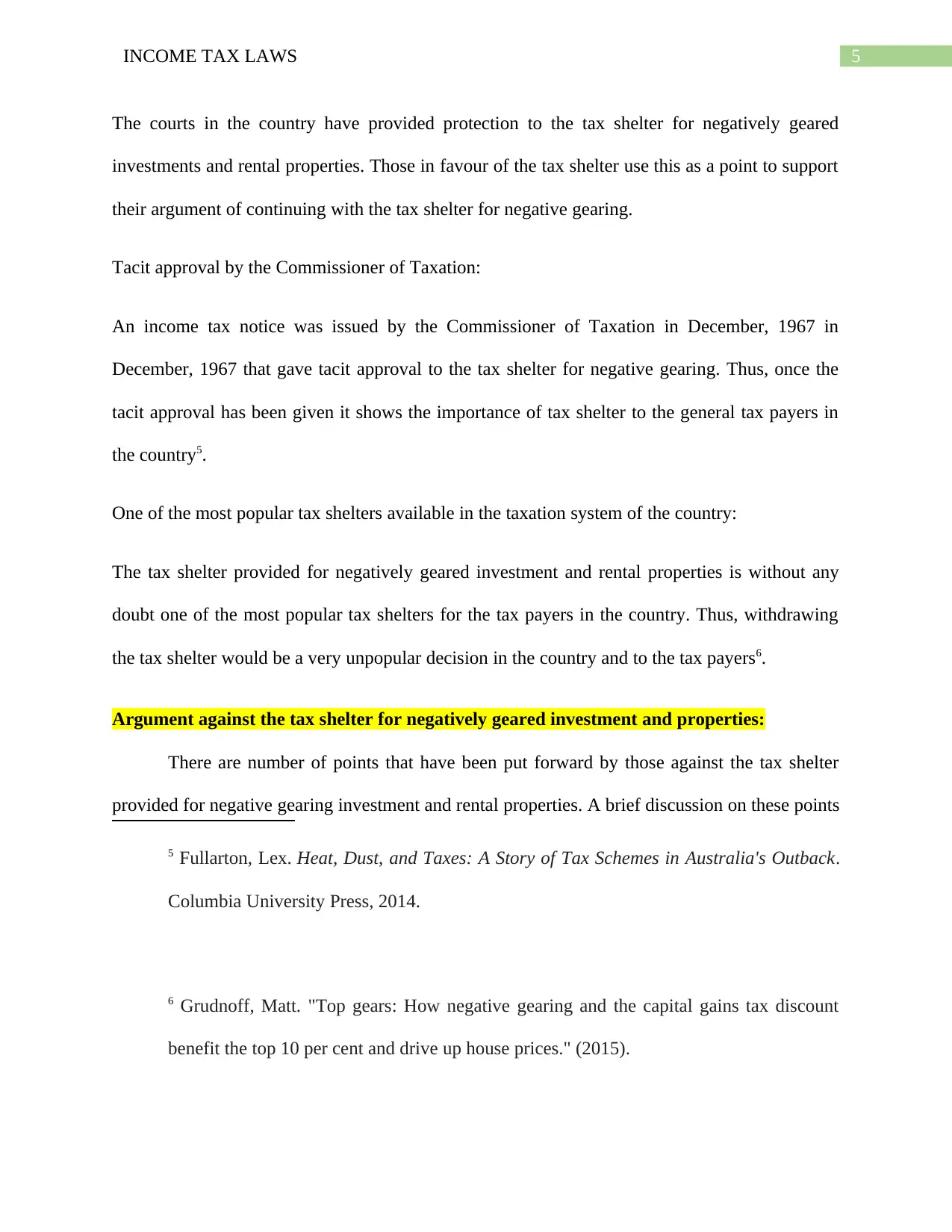
5INCOME TAX LAWS
The courts in the country have provided protection to the tax shelter for negatively geared
investments and rental properties. Those in favour of the tax shelter use this as a point to support
their argument of continuing with the tax shelter for negative gearing.
Tacit approval by the Commissioner of Taxation:
An income tax notice was issued by the Commissioner of Taxation in December, 1967 in
December, 1967 that gave tacit approval to the tax shelter for negative gearing. Thus, once the
tacit approval has been given it shows the importance of tax shelter to the general tax payers in
the country5.
One of the most popular tax shelters available in the taxation system of the country:
The tax shelter provided for negatively geared investment and rental properties is without any
doubt one of the most popular tax shelters for the tax payers in the country. Thus, withdrawing
the tax shelter would be a very unpopular decision in the country and to the tax payers6.
Argument against the tax shelter for negatively geared investment and properties:
There are number of points that have been put forward by those against the tax shelter
provided for negative gearing investment and rental properties. A brief discussion on these points
5 Fullarton, Lex. Heat, Dust, and Taxes: A Story of Tax Schemes in Australia's Outback.
Columbia University Press, 2014.
6 Grudnoff, Matt. "Top gears: How negative gearing and the capital gains tax discount
benefit the top 10 per cent and drive up house prices." (2015).
The courts in the country have provided protection to the tax shelter for negatively geared
investments and rental properties. Those in favour of the tax shelter use this as a point to support
their argument of continuing with the tax shelter for negative gearing.
Tacit approval by the Commissioner of Taxation:
An income tax notice was issued by the Commissioner of Taxation in December, 1967 in
December, 1967 that gave tacit approval to the tax shelter for negative gearing. Thus, once the
tacit approval has been given it shows the importance of tax shelter to the general tax payers in
the country5.
One of the most popular tax shelters available in the taxation system of the country:
The tax shelter provided for negatively geared investment and rental properties is without any
doubt one of the most popular tax shelters for the tax payers in the country. Thus, withdrawing
the tax shelter would be a very unpopular decision in the country and to the tax payers6.
Argument against the tax shelter for negatively geared investment and properties:
There are number of points that have been put forward by those against the tax shelter
provided for negative gearing investment and rental properties. A brief discussion on these points
5 Fullarton, Lex. Heat, Dust, and Taxes: A Story of Tax Schemes in Australia's Outback.
Columbia University Press, 2014.
6 Grudnoff, Matt. "Top gears: How negative gearing and the capital gains tax discount
benefit the top 10 per cent and drive up house prices." (2015).
⊘ This is a preview!⊘
Do you want full access?
Subscribe today to unlock all pages.

Trusted by 1+ million students worldwide
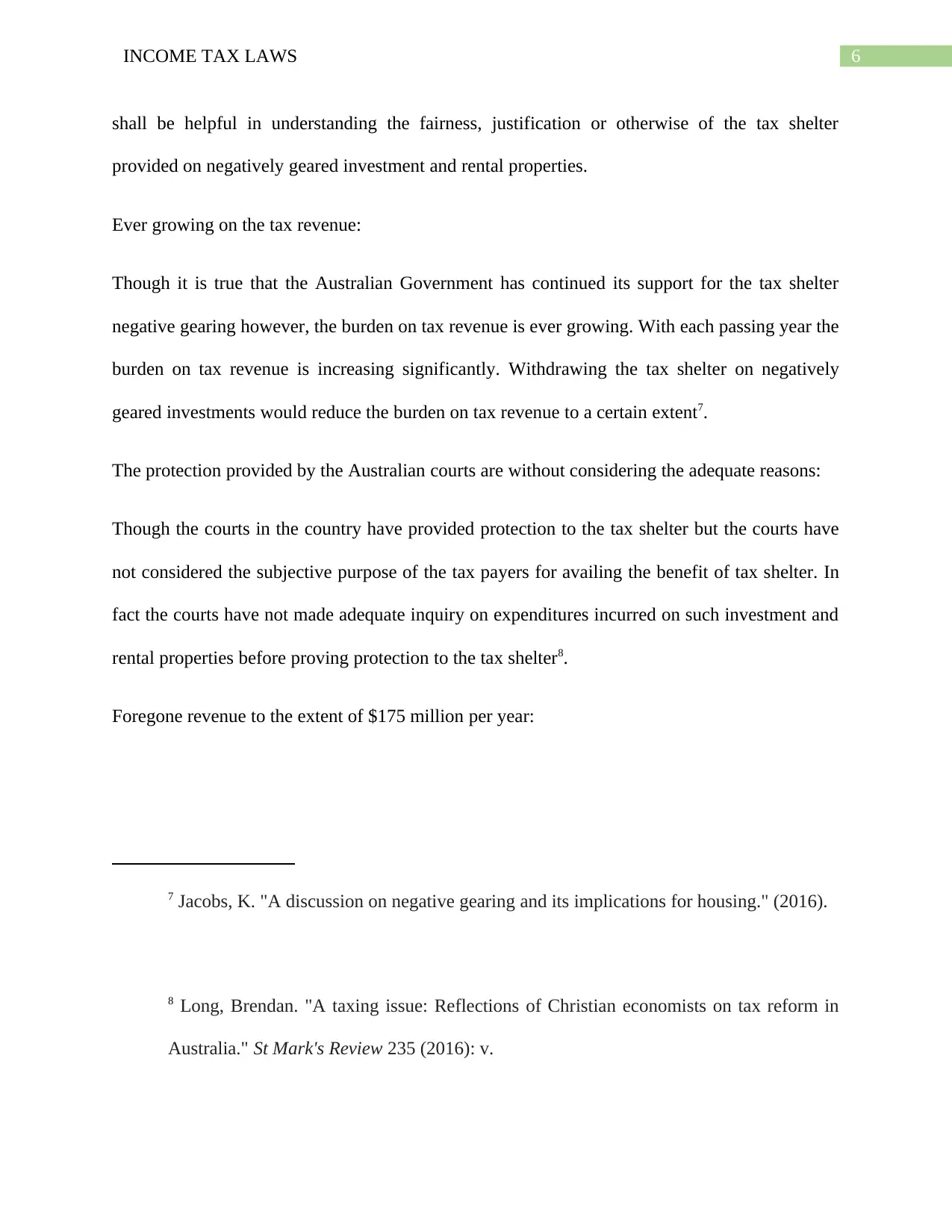
6INCOME TAX LAWS
shall be helpful in understanding the fairness, justification or otherwise of the tax shelter
provided on negatively geared investment and rental properties.
Ever growing on the tax revenue:
Though it is true that the Australian Government has continued its support for the tax shelter
negative gearing however, the burden on tax revenue is ever growing. With each passing year the
burden on tax revenue is increasing significantly. Withdrawing the tax shelter on negatively
geared investments would reduce the burden on tax revenue to a certain extent7.
The protection provided by the Australian courts are without considering the adequate reasons:
Though the courts in the country have provided protection to the tax shelter but the courts have
not considered the subjective purpose of the tax payers for availing the benefit of tax shelter. In
fact the courts have not made adequate inquiry on expenditures incurred on such investment and
rental properties before proving protection to the tax shelter8.
Foregone revenue to the extent of $175 million per year:
7 Jacobs, K. "A discussion on negative gearing and its implications for housing." (2016).
8 Long, Brendan. "A taxing issue: Reflections of Christian economists on tax reform in
Australia." St Mark's Review 235 (2016): v.
shall be helpful in understanding the fairness, justification or otherwise of the tax shelter
provided on negatively geared investment and rental properties.
Ever growing on the tax revenue:
Though it is true that the Australian Government has continued its support for the tax shelter
negative gearing however, the burden on tax revenue is ever growing. With each passing year the
burden on tax revenue is increasing significantly. Withdrawing the tax shelter on negatively
geared investments would reduce the burden on tax revenue to a certain extent7.
The protection provided by the Australian courts are without considering the adequate reasons:
Though the courts in the country have provided protection to the tax shelter but the courts have
not considered the subjective purpose of the tax payers for availing the benefit of tax shelter. In
fact the courts have not made adequate inquiry on expenditures incurred on such investment and
rental properties before proving protection to the tax shelter8.
Foregone revenue to the extent of $175 million per year:
7 Jacobs, K. "A discussion on negative gearing and its implications for housing." (2016).
8 Long, Brendan. "A taxing issue: Reflections of Christian economists on tax reform in
Australia." St Mark's Review 235 (2016): v.
Paraphrase This Document
Need a fresh take? Get an instant paraphrase of this document with our AI Paraphraser
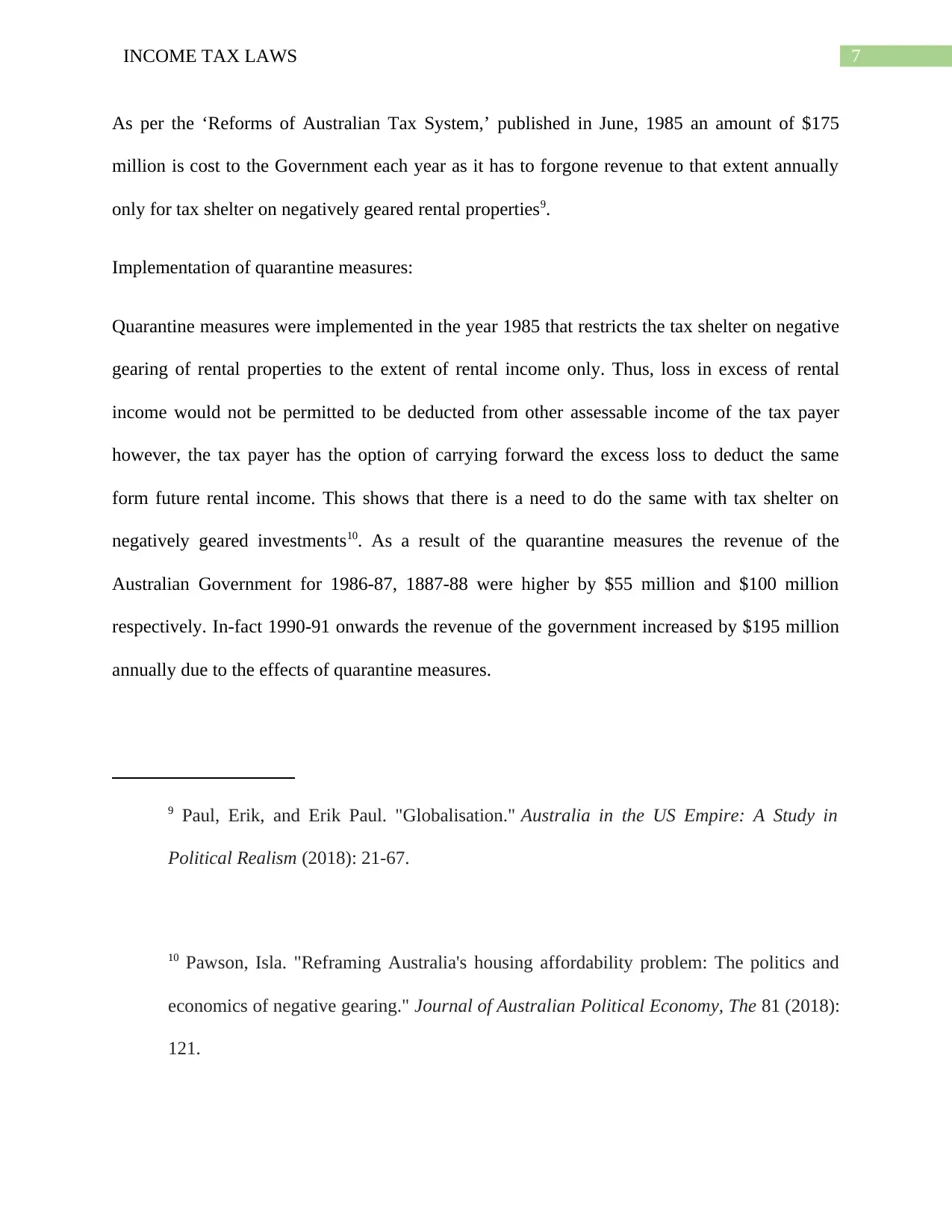
7INCOME TAX LAWS
As per the ‘Reforms of Australian Tax System,’ published in June, 1985 an amount of $175
million is cost to the Government each year as it has to forgone revenue to that extent annually
only for tax shelter on negatively geared rental properties9.
Implementation of quarantine measures:
Quarantine measures were implemented in the year 1985 that restricts the tax shelter on negative
gearing of rental properties to the extent of rental income only. Thus, loss in excess of rental
income would not be permitted to be deducted from other assessable income of the tax payer
however, the tax payer has the option of carrying forward the excess loss to deduct the same
form future rental income. This shows that there is a need to do the same with tax shelter on
negatively geared investments10. As a result of the quarantine measures the revenue of the
Australian Government for 1986-87, 1887-88 were higher by $55 million and $100 million
respectively. In-fact 1990-91 onwards the revenue of the government increased by $195 million
annually due to the effects of quarantine measures.
9 Paul, Erik, and Erik Paul. "Globalisation." Australia in the US Empire: A Study in
Political Realism (2018): 21-67.
10 Pawson, Isla. "Reframing Australia's housing affordability problem: The politics and
economics of negative gearing." Journal of Australian Political Economy, The 81 (2018):
121.
As per the ‘Reforms of Australian Tax System,’ published in June, 1985 an amount of $175
million is cost to the Government each year as it has to forgone revenue to that extent annually
only for tax shelter on negatively geared rental properties9.
Implementation of quarantine measures:
Quarantine measures were implemented in the year 1985 that restricts the tax shelter on negative
gearing of rental properties to the extent of rental income only. Thus, loss in excess of rental
income would not be permitted to be deducted from other assessable income of the tax payer
however, the tax payer has the option of carrying forward the excess loss to deduct the same
form future rental income. This shows that there is a need to do the same with tax shelter on
negatively geared investments10. As a result of the quarantine measures the revenue of the
Australian Government for 1986-87, 1887-88 were higher by $55 million and $100 million
respectively. In-fact 1990-91 onwards the revenue of the government increased by $195 million
annually due to the effects of quarantine measures.
9 Paul, Erik, and Erik Paul. "Globalisation." Australia in the US Empire: A Study in
Political Realism (2018): 21-67.
10 Pawson, Isla. "Reframing Australia's housing affordability problem: The politics and
economics of negative gearing." Journal of Australian Political Economy, The 81 (2018):
121.
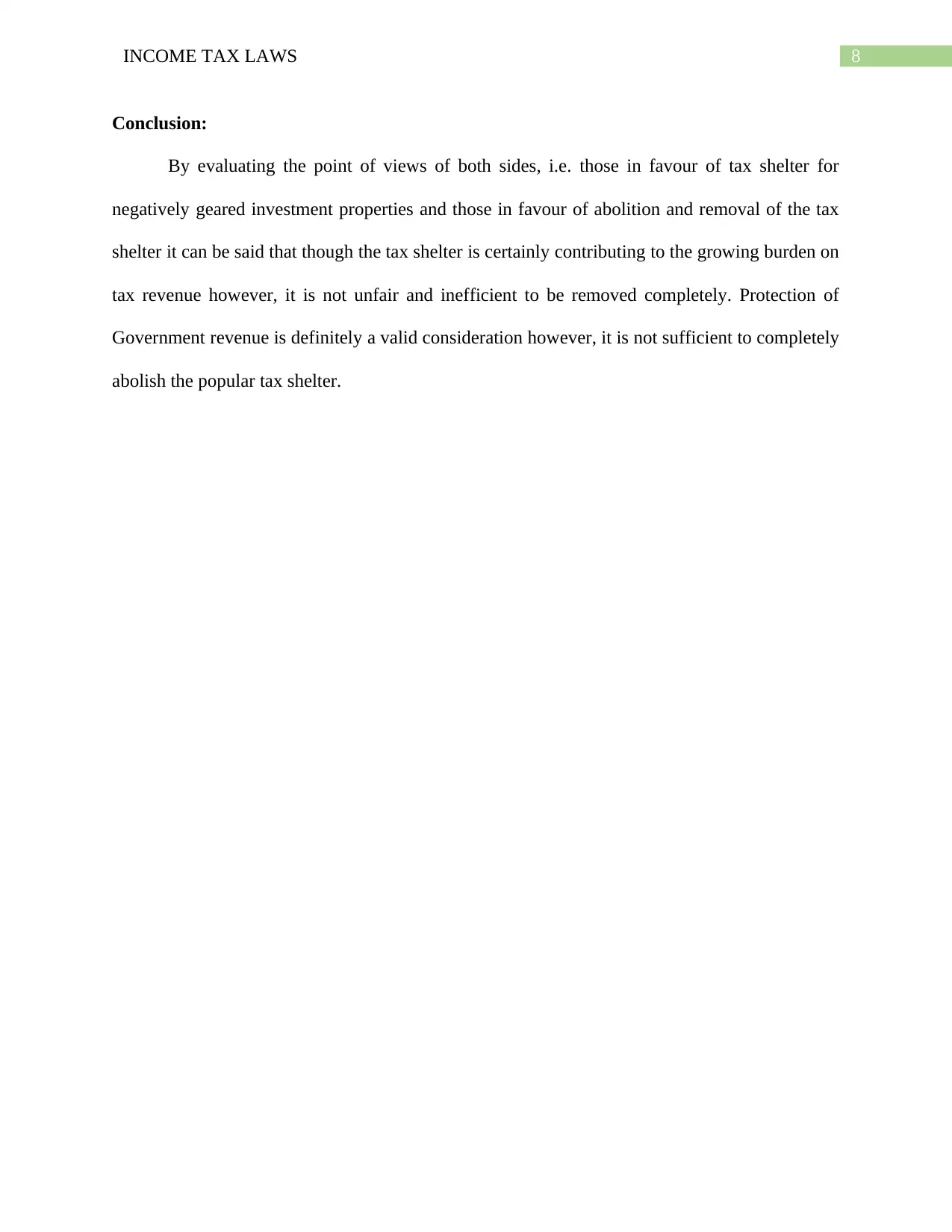
8INCOME TAX LAWS
Conclusion:
By evaluating the point of views of both sides, i.e. those in favour of tax shelter for
negatively geared investment properties and those in favour of abolition and removal of the tax
shelter it can be said that though the tax shelter is certainly contributing to the growing burden on
tax revenue however, it is not unfair and inefficient to be removed completely. Protection of
Government revenue is definitely a valid consideration however, it is not sufficient to completely
abolish the popular tax shelter.
Conclusion:
By evaluating the point of views of both sides, i.e. those in favour of tax shelter for
negatively geared investment properties and those in favour of abolition and removal of the tax
shelter it can be said that though the tax shelter is certainly contributing to the growing burden on
tax revenue however, it is not unfair and inefficient to be removed completely. Protection of
Government revenue is definitely a valid consideration however, it is not sufficient to completely
abolish the popular tax shelter.
⊘ This is a preview!⊘
Do you want full access?
Subscribe today to unlock all pages.

Trusted by 1+ million students worldwide
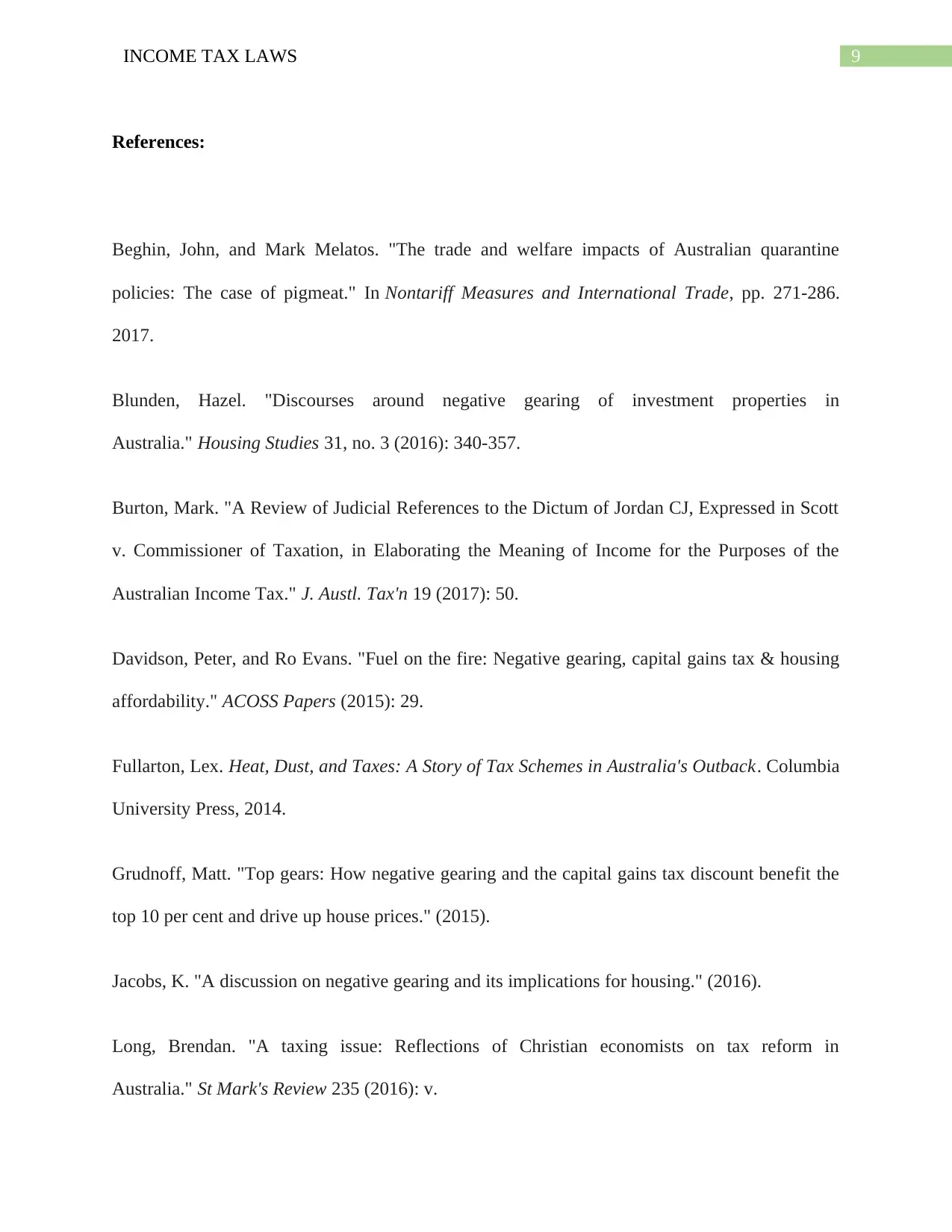
9INCOME TAX LAWS
References:
Beghin, John, and Mark Melatos. "The trade and welfare impacts of Australian quarantine
policies: The case of pigmeat." In Nontariff Measures and International Trade, pp. 271-286.
2017.
Blunden, Hazel. "Discourses around negative gearing of investment properties in
Australia." Housing Studies 31, no. 3 (2016): 340-357.
Burton, Mark. "A Review of Judicial References to the Dictum of Jordan CJ, Expressed in Scott
v. Commissioner of Taxation, in Elaborating the Meaning of Income for the Purposes of the
Australian Income Tax." J. Austl. Tax'n 19 (2017): 50.
Davidson, Peter, and Ro Evans. "Fuel on the fire: Negative gearing, capital gains tax & housing
affordability." ACOSS Papers (2015): 29.
Fullarton, Lex. Heat, Dust, and Taxes: A Story of Tax Schemes in Australia's Outback. Columbia
University Press, 2014.
Grudnoff, Matt. "Top gears: How negative gearing and the capital gains tax discount benefit the
top 10 per cent and drive up house prices." (2015).
Jacobs, K. "A discussion on negative gearing and its implications for housing." (2016).
Long, Brendan. "A taxing issue: Reflections of Christian economists on tax reform in
Australia." St Mark's Review 235 (2016): v.
References:
Beghin, John, and Mark Melatos. "The trade and welfare impacts of Australian quarantine
policies: The case of pigmeat." In Nontariff Measures and International Trade, pp. 271-286.
2017.
Blunden, Hazel. "Discourses around negative gearing of investment properties in
Australia." Housing Studies 31, no. 3 (2016): 340-357.
Burton, Mark. "A Review of Judicial References to the Dictum of Jordan CJ, Expressed in Scott
v. Commissioner of Taxation, in Elaborating the Meaning of Income for the Purposes of the
Australian Income Tax." J. Austl. Tax'n 19 (2017): 50.
Davidson, Peter, and Ro Evans. "Fuel on the fire: Negative gearing, capital gains tax & housing
affordability." ACOSS Papers (2015): 29.
Fullarton, Lex. Heat, Dust, and Taxes: A Story of Tax Schemes in Australia's Outback. Columbia
University Press, 2014.
Grudnoff, Matt. "Top gears: How negative gearing and the capital gains tax discount benefit the
top 10 per cent and drive up house prices." (2015).
Jacobs, K. "A discussion on negative gearing and its implications for housing." (2016).
Long, Brendan. "A taxing issue: Reflections of Christian economists on tax reform in
Australia." St Mark's Review 235 (2016): v.
Paraphrase This Document
Need a fresh take? Get an instant paraphrase of this document with our AI Paraphraser
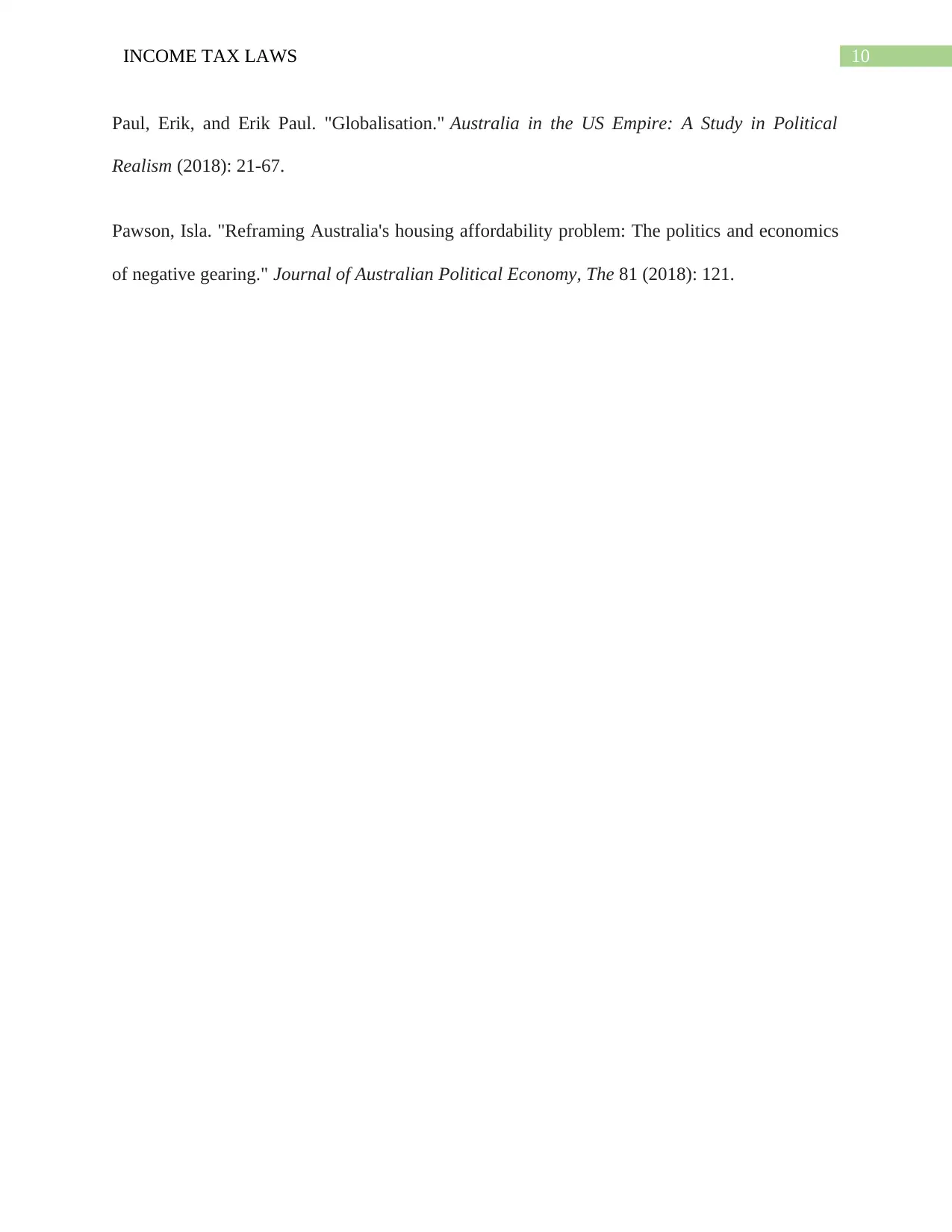
10INCOME TAX LAWS
Paul, Erik, and Erik Paul. "Globalisation." Australia in the US Empire: A Study in Political
Realism (2018): 21-67.
Pawson, Isla. "Reframing Australia's housing affordability problem: The politics and economics
of negative gearing." Journal of Australian Political Economy, The 81 (2018): 121.
Paul, Erik, and Erik Paul. "Globalisation." Australia in the US Empire: A Study in Political
Realism (2018): 21-67.
Pawson, Isla. "Reframing Australia's housing affordability problem: The politics and economics
of negative gearing." Journal of Australian Political Economy, The 81 (2018): 121.
1 out of 11
Related Documents
Your All-in-One AI-Powered Toolkit for Academic Success.
+13062052269
info@desklib.com
Available 24*7 on WhatsApp / Email
![[object Object]](/_next/static/media/star-bottom.7253800d.svg)
Unlock your academic potential
Copyright © 2020–2025 A2Z Services. All Rights Reserved. Developed and managed by ZUCOL.




